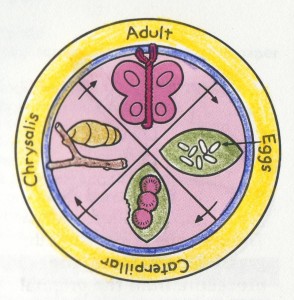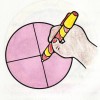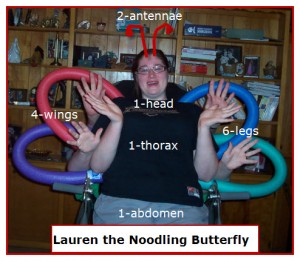Metamorphosis is a series of changes. The metamorphosis of a butterfly (life cycle) can be modeled using a few craft items, including a paper plate, construction paper and other stuff shown in the diagram.

Discover for Yourself
1. Draw and cut out a 6-inch circle from construction paper. (Color is optional).
2. Fold the paper circle in half twice.
3. Unfold the paper and with a marker, draw two lines along the fold lines. These lines divide the paper into 4 equal pie shape parts.

4. Glue the circle in the center of a white paper plate.
Adult Butterfly
5. Fold a 4-inch square piece of construction paper (any color) in half and draw a wing shape as shown.
6. Cut out the wings by cutting through both layers of paper.
7. Unfold the wings and use a marking pen to decorate the wings of the butterfly. Make the decorations on the wings on the right side match the wings on the left side.
8. Twist a 6-inch craft stem (any color) around the center of the wings to form the body and antennae of the adult butterfly.
9. Glue the paper adult butterfly in one of the pie shaped sections.
Eggs and Caterpillar (Larva)
10. Cut 2 leaves from green construction paper.
- Glue one of the leaves in the section to the right of the adult butterfly. Glue dry rice grains on this leaf. (The rice represents the eggs laid by the adult on the leaf.) Write “Egg” on the plate and use an arrow to point to one of the eggs.
- Cut notches out of the second leaf. This represents places where the caterpillar ate some of the leaf. Glue the leaf in the next section on the plate.
11. Glue three small pom-poms on top of the leaf. This represents one caterpillar (aka larva). Write “Caterpillar” on the plate.
Chrysalis (Pupae)
12. In the last section, glue a wooden twig. Roll a small piece of masking tape into a small tube-like shape and glue it next to the twig. The tape represent a chrysalis. Write “Chrysalis” on the plate.
13. Draw arrows between the sections on the paper as shown.
14. Rotate the plate counterclockwise and see the metamorphosis (life cycle) of a butterfly.
Summary
A butterfly is a type of insect.
Insects: Animals. Some insects, such as butterflies have wings. Some insects, such as ants do not have wings. But all insects have three body parts and six legs attached to the second body part.
The life cycle of butterflies is called complete metamorphosis.
Complete metamorphosis has four basic steps.
1. Adult female butterfly lays eggs.
2. Butterfly eggs hatch forming larvae (caterpillars).
3. As the caterpillars grow, they molt, which means they shed their outer skin. After the last molt, a harden shell forms around the caterpillar. This stage of development is called the pupae and the covering is called a chrysalis.
4. Inside the chrysalis, the caterpillar actually breaks up and the material recombines forming an adult butterfly.
Egg –> Larva–>Pupae–> Adult butterfly
There are no “baby” butterflies. Butterflies are adults when they hatch out of the chrysalis. Most insects, including flies, moths, and beetles, form by complete metamorphosis.
Note: Female and male insects mate. The eggs laid by the female are said to be fertilized, meaning they have genetic material from both the male and female.
Just for Fun:
I asked my granddaughter to hold the four foam noodles so I could get a picture of them. While I was getting my camera, she created wings with the noodles and then other family members joined in to make this butterfly have six legs.
You could have your student to create fun models of a butterfly.
For more information and activities about science, see
The book is designed to help young students catch the “science bug”
Teaching the Fun of Science to Young Learners
The book’s 75 lessons and reproducible activities touch on all areas of science and provide the key to a world of science magic and mystery. While kids will have fun doing the activities and learning to love science, they are also being encouraged to develop other skills, including reading, writing, math, and art.
(Paid Link)

